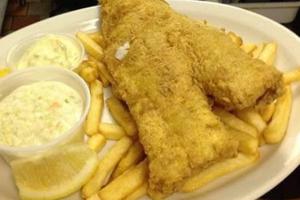For ‘Fishers of Men,’ the Parish Fish Fry Is a Good Place to Let Down Our Nets
It’s frustrating that more people seem to attend our Lenten fish fry than Sunday Mass, but the Lord can do great things with patient and trusting fishermen.

Every year since coming to this urban rust-belt parish I have complained about the fact that our fish fry is more popular than Sunday Mass.
I know that some people who won’t make their Easter duty will be at our dinners every Friday without fail. There is a faithful remnant that I see at church, of course, and I know that there are members who come on Fridays from other parishes in the area who practice their religion faithfully in their communities, but many of our clientele are Catholics in the non-active category of their parishes. (Some Protestants who have developed Catholic palates for Fridays in Lent also come.)
It used to upset me walking through the crowded basement cafeteria on the days of our fish fries and wondering how to get people to come upstairs where the real action is, but I have decided not to complain this year and instead to see the phenomenon in a different light — our faithful team of cooks and clean up are engaged in a pre-evangelization with the themes of identity and symbol recognition. I am working on printing a placemat that puts the Lenten fish fry into the context of celebrating identity and pointing out Gospel links.
Recently, I read about a connection between the early Christians and the Essene communities. Both believed in table fellowship. The agapes of the Christians and the community meals of the Essenes were not fundraisers, but the theme of the shared meal is certainly related to evangelization. The highest prayer of our religion, the sacrifice of the Mass, stems from the table fellowship of Jesus and his apostles. Connected to a congregation, a fish fry is in some respects a communal meal. At our parish, it is definitely a neighborhood gathering.
Secondly, it is a meal that reflects religious principles. Catholics do not observe kosher but still have a few dietary laws. Fasting on Ash Wednesday and Good Friday is only a faint echo of Catholic tradition, but the abstinence from meat on Fridays in Lent remains an aspect of Catholic identity. Remembering that it was on a Friday that our Lord was crucified, we are asked to mark the day with a token sacrifice. In the age of vegans, that might not seem much, but identity is often in the details. Fish fries remind us of our Catholic identity, which has lost much definition in the past three-quarters of a century.
Thirdly, although we have shrimp dinners, fish meals have a lot of Gospel resonance. Jesus knew something about fish. His first disciples were fishermen (Matthew 4:18-22). He used their boat as a pulpit (Matthew 13:1-25) and even gave instructions twice for better catches, once after his death and resurrection (John 21:6). Two of his miracles involved the multiplication of fish along with loaves of bread. He fed thousands of people at those times and did not have to worry about the parking lot traffic (Mark 6:38-44; Mark 8:1-9).
The Gospels even speak of Jesus preparing a fish meal for the apostles on the shores of Galilee when he appeared to them after his Resurrection (John 21:9-12). We know, also, that Jesus ate fish. When he appeared to the disciples in the Upper Room, they gave him a piece of broiled fish to eat (Luke 24:42).
There is more fish motif in the Scriptures. Jesus at one point says that his contemporaries would be given the “Sign of Jonah” (Matthew 12:39-40) This refers to the prophet who was swallowed by a “big fish” (the Bible does not call it a whale) and then emerges after three days, like Jesus did from the tomb.
Another fishy connection comes from history. The fish symbol has been used by Christians as identification since Roman times. When it was first used, at a time when Christian worship was still clandestine and in the catacombs, it was a secret sign of identity. The letters of the word in Greek for fish, ichthys, form an acronym of the words, “Jesus Christ, God’s Son, Savior.” It was a shorthand profession of faith. The emperor Augustus was also called “son of god” (divi filius) and in Greek, “savior” (soter), so there was a note of contradiction of the powers that be in the coding. The symbol users implied, “We know who the real Son of God and Savior is.”
It is still a great profession of faith: Jesus is the Son of God, the Second Person of the Holy Trinity, and our Savior. It is Catholicism in a kernel, and so a wonderful symbol. Catholics, because of our lamentable symbolic illiteracy — the result of the crime of so many 60s and 70s catechetical experts and publishers — don’t always know what the Christian bumper stickers are saying or why religious bookstores have the drawing of a fish in various places, but they can learn it at a fish fry.
One of my parish’s benefactors told me at a dark spot last year never to give up the traditional fish fry during Lent because it was a “reference point” for the neighborhood. I thought I saw what he meant at the time, but my subsequent reflection sees the insight as deeper than a question of activity. Our parish fish fry has been a kind of pre-evangelization and a re-evangelization unconsciously. Now, how to make that more of a conscious exercise without a counter-productive “preachiness” is what I have to work on.

















